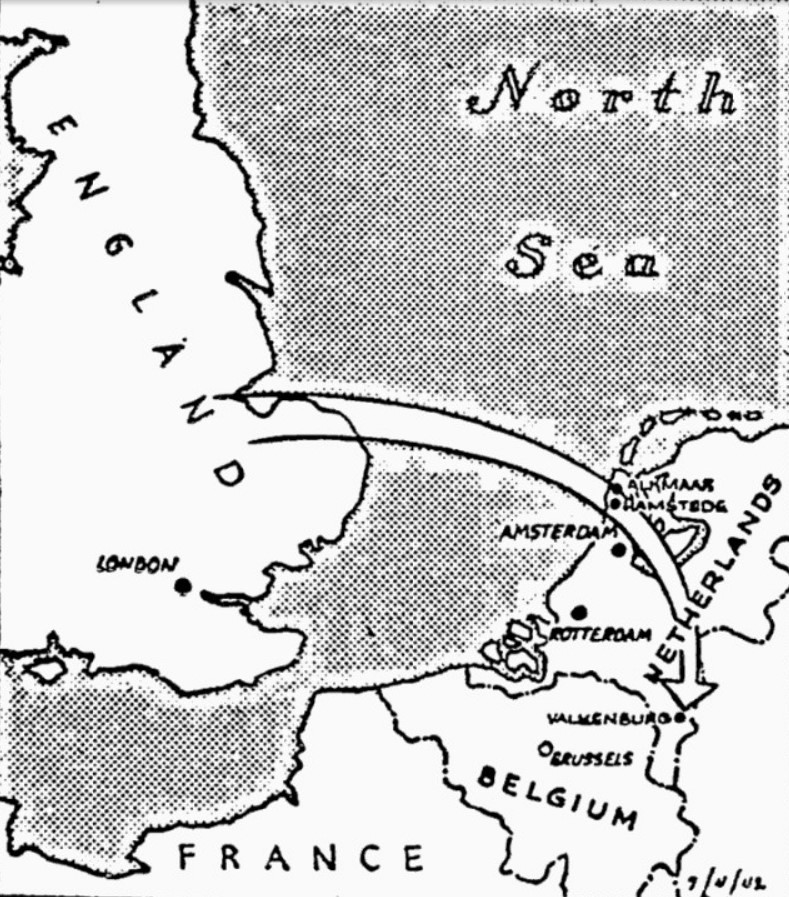The Pittsburgh Press (July 5, 1942)
U.S. FLIERS BOMB EUROPE
Americans blast Dutch airfields, lose two planes
Six bombers skim treetops in daylight raid, one hits ground but gets home
By Edward W. Beattie, United Press staff writer
London, England – (July 4)
U.S. Army bombers, flying 300 miles an hour in daylight over the treetops of Holland, blasted administration buildings, personnel and grounded airplanes at three German airdromes on this Fourth of July morning.
The raid was officially called:
…the beginning of an attack that will make Germany rue the day she plunged the world into war.
Flying very low, six twin-motored light bombers of the Douglas A-20A type – manned by U.S. fliers – joined six similar RAF bombers in a daylight roundtrip sweep of 400-500 miles almost to the German border at Aix-la-Chapelle. Airdromes at Alkmaar, Valkenburg and Haamstede were attacked. There was no fighter escort.
Where U.S. fliers raided Nazis is indicated by the arrow from the English coast to three airdromes in Holland at Haamstede, Alkmaar and Valkenburg. The first two are near Amsterdam about 125 miles from England. Valkenburg is about 200 miles from Dover.
Two U.S. bombers and one RAF bomber were lost.
Damage to aircraft on the ground and buildings was “considerable” and German soldiers were mowed down by a hurricane of machine-gun and cannon fire, according to U.S. General Headquarters.
The statement said:
About 150 Germans in flying kit were caught flat-footed as if on parade. These troops dispersed in all directions under heavy machine-gun fire from the front guns.
Maj. Gen. Dwight D. Eisenhower, U.S. commander in Europe, awarded the Distinguished Service Cross to one pilot, Capt. Charles C. Kegelman, of El Reno, Oklahoma, whose coolness and bravery brought his crew safely home after their blazing plane actually struck the ground while attacking the enemy target.
The boldness of Capt. Kegelman and his crew illustrated the fury with which the Americans and British struck. His bomber was hit by anti-aircraft fire, the propeller and nose section of his starboard engine were shot off, the tail was full of holes, one motor was afire.
Headquarters said:
The plane hit the ground, damaging the starboard wing and knocking a large hole in the bottom of the fuselage.
Yet Capt. Kegelman pulled out of the dive, headed straight for an anti-aircraft tower that was firing at him, opened up with his front guns on the tower – forcing it to cease firing – and then took his crew home on one motor.
One of the two U.S. planes lost was shot down by anti-aircraft guns. The RAF lost one bomber.
British Air Marshal A. T. Harris, in a message to the commanding general of the U.S. Army Bomber Command, said:
From this beginning will spring an even growing weight of attack… I know your magnificent youngsters will fetch a grunt out of the enemy with the first punch.
The message said that the attack would make American Independence Day still more significant for “our two peoples.”
U.S. troops also first went into action in France in World War I, July 4.
An Air Ministry communiqué said:
At Haamstede and Alkmaar [20 miles west and northwest of Amsterdam and 125 miles from eastern England], bombs were seen to burst in hangars and administrative buildings. The Valkenburg field [in southern Holland, 200 miles from England] was heavily machine-gunned and an enemy fighter on the ground set afire.
Enemy patrol vessels off the Dutch coast were also attacked.
The loss of two of six U.S. planes was not regarded as an unusually high percentage for daylight raiding.
The technique on such daylight raids is to cross the coastline only a few hundred feet above the sand and then drop down to the housetops, which would permit the people of occupied Holland and Belgium to see the U.S. insignia on the attacking planes.
It is generally believed that some time will elapse before American participation in raids on the European occupied zones can reach a high pitch, but regular RAF devastation raids are expected throughout the summer.
